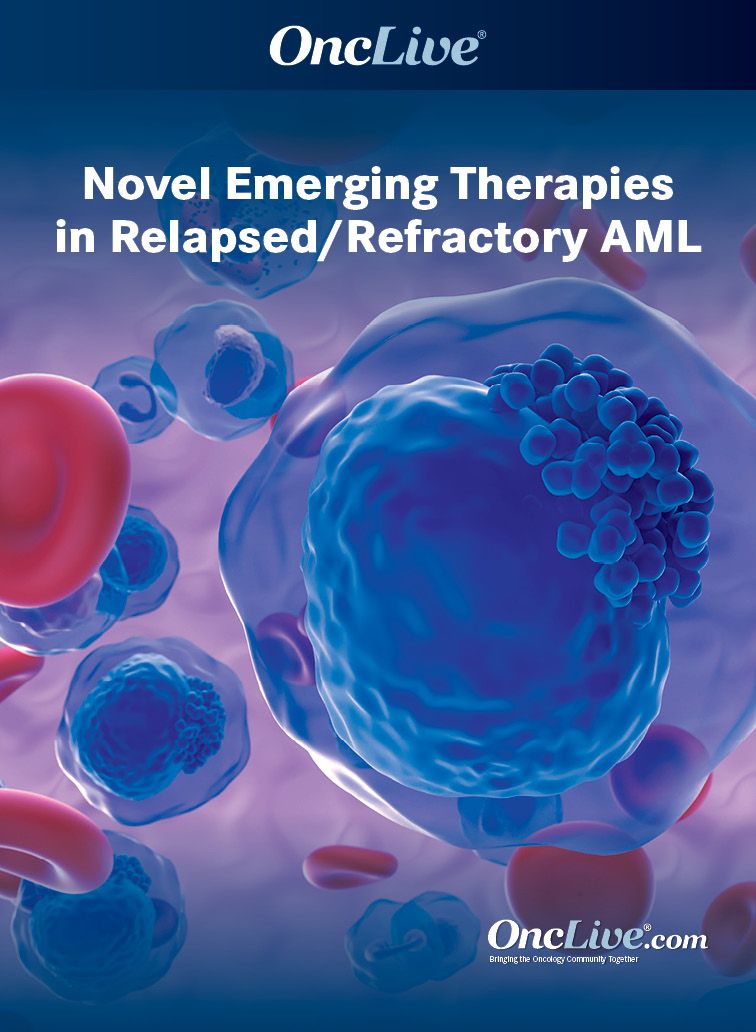News
Article
Supplements and Featured Publications
Uproleselan Plus SOC Targeted Regimens and Chemotherapy Under Investigation in AML
Author(s):
Bhavana “Tina” Bhatnagar, DO, discusses the mechanism of action of uproleselan, the potential efficacy and safety benefits of adding this agent to standard therapeutic regimens in patients with AML, and the importance of considering MRD negativity as an end point in AML clinical trials.
Bhavana “Tina” Bhatnagar, DO

Preliminary findings from clinical trials investigating uproleselan (GM-1271) in combination with standard-of-care (SOC) venetoclax (Venclexta) and azacitidine (Vidaza) or MEC (mitoxantrone, etoposide, and cytarabine) chemotherapy in patients with acute myeloid leukemia (AML) continue to demonstrate the potential for improving responses, leading to minimal residual disease (MRD) negativity in this population, according to Bhavana “Tina” Bhatnagar, DO.
Currently, a phase 1 trial (NCT04964505) is investigating the addition of the E-selectin antagonist uproleselan to azacitidine and venetoclax in patients with treatment-naïve AML, with safety as the primary end point and preliminary efficacy as a secondary end point.1
Additionally, a phase 3 trial (NCT03616470) is evaluating the efficacy and safety of uproleselan plus MEC in patients with relapsed/refractory AML.2 Overall survival (OS) serves as the primary end point of this trial, with rate of severe oral mucositis and overall response rate as key secondary end points. The initiation of this trial was supported by findings from a phase 1/2 trial (NCT02306291) evaluating the safety and efficacy of MEC plus uproleselan, which showed a complete response (CR)/CR with incomplete count recovery (CRi) rate of 41% and a median OS of 8.8 months in patients with relapsed/refractory AML, as well as a CR/CRi rate of 72% and a median OS of 12.6 months in patients with newly diagnosed disease.3
“[Uproleselan] could become a new SOC because it can be used in all subtypes of AML; it’s not restricted to specific molecular subgroups,” Bhatnagar said.
In an interview with OncLive®, Bhatnagar discussed the mechanism of action of uproleselan, the potential efficacy and safety benefits of adding this agent to standard therapeutic regimens in patients with AML, and the importance of considering MRD negativity as an end point in AML clinical trials.
Bhatnagar is an assistant professor in the Department of Medicine at West Virginia University, as well as an associate professor in the Section of Hematology/Oncology and the director of Hematology and Medical Oncology at West Virginia University Cancer Institute, both in Morgantown.
OncLive: What is the rationale for targeting E-selectin in patients with AML?
Bhatnagar: E-selectin is an attractive target for therapy in AML. It’s an adhesion molecule that regulates vascular endothelial cell expression under normal conditions. It’s important for supporting the bone marrow microenvironment. In [healthy] people, it allows for healthy growth of blood cells within the bone marrow.
However, AML cells have developed ways to express the E-selectin ligand on their cell surfaces, and they essentially hijack that entire system, and, in a way, they are able to escape chemotherapy. They use the microenvironment to support their own growth. The thought is that if we can disrupt the interaction with the E-selectin ligand on the AML cells, they won’t have the protective cover they’re trying to use to support their own growth and survival.
How is this uproleselan designed to target E-selectin in patients with AML?
Uproleselan is a glycomimetic that disrupts the interaction of the E-selectin ligand on the surfaces of AML cells. This drug allows those cells to be killed by chemotherapy. That’s the rationale behind trying to use it [in patients with AML].
How might the addition of uproleselan to venetoclax plus azacitidine increase the efficacy of this SOC regimen for patients with AML?
Azacitidine and venetoclax has become a new SOC for older or unfit patients with AML. I use the term “unfit” loosely because there’s some controversy over what that term means. The combination was studied in older patients with AML patients, and it showed excellent response rates relative to those with azacitidine alone. For many of us, that [combination] has become the SOC.
One of the limitations of the [phase 3] VIALE-A trial [NCT02993523], which investigated azacitidine and venetoclax, was the levels of MRD achievement and patients who achieved a CR. There was still room to potentially improve upon the responses that were seen with the doublet.
Some preliminary data that were seen regarding MRD negativity in other uproleselan trials showed that the drug could potentially produce more MRD negative states. We try to achieve MRD negativity in AML because patients who fully clear their disease ultimately do much better from a survival standpoint.
The question becomes: Does the addition of uproleselan improve response rates? Does it increase the toxicity profile? [Does it play] a role in the achievement of MRD negativity? That’s why a phase 1 trial being conducted only through the University of California [Davis] is ongoing. The preliminary results [from that trial] seem promising.
What is currently known about MRD negativity in AML, and how might this outcome be used as a potential predictor of therapeutic success in patients undergoing transplant or requiring subsequent therapy?
MRD is more controversial in AML compared with its well-defined role in acute lymphoblastic leukemia [ALL], where even small amounts of disease predict for worse survival. In AML, MRD negativity has been shown to improve survival outcomes. However, the controversy has been: How do we define MRD negativity? What assays do we use, and what’s the sensitivity of those assays?
[The achievement of] undetectable disease by flow cytometry or next-generation sequencing, showing the absence of any recurrent mutations that patients had at the time of diagnosis, predicts better responses in the post-transplant setting. There is a lot of interest in trying to achieve as much disease control as possible to improve outcomes. However, there are still many questions about the best way to determine whether a patient is truly MRD negative.
The uproleselan studies used multiparameter flow cytometry, which is 1 way to detect MRD. However, that depends on the sensitivity of the assay and how well it can detect 1 leukemic cell in a population of cells. AML remains notoriously difficult to cure, and a large part of the reason for that is because we never know where an AML cell happens to be. They tend to be proliferative.
What is the rationale for using MRD negativity as a primary end point in clinical trials rather than traditional primary end points such as progression-free survival and OS?
[MRD negativity is] a good end point. It matters for prognosis, because patients and their families are interested in knowing [the benefits of] achieving MRD [negativity] and what level of MRD is significant for predicting relapse and disease survival. It’s a reasonable [end point to consider] in the context of the bigger picture of whether [clinical trial findings] translate into meaningful [information] for patients.
How has uproleselan performed when added to different chemotherapy backbones in patients with AML?
Uproleselan became much more visible when it was studied in the context of intensive chemotherapy backbones. A phase 1/2 trial, [findings from which were] published in Blood in 2022 with Daniel J. DeAngelo, MD, [of Dana-Farber Cancer Institute in Boston, Massachusetts] as the first author, [included] 3 different cohorts of patients. Two of those cohorts were in the relapsed/refractory setting with MEC—a commonly used intensive chemotherapy regimen—in combination with uproleselan. The only difference between those cohorts was 1 was dose escalation and the second was dose expansion. A third cohort of older, newly diagnosed adult patients were treated with uproleselan and 7+3 chemotherapy.
The cohort that received MEC [at the recommended phase 2 dose] had a 41% CR/CRi rate. Several of those patients achieved MRD negativity as well. The response rates were promising, but other notable findings included the fact that toxicities were not increased with uproleselan. They were similar to what we expect with MEC alone. There were also lower rates of mucositis, which is notorious with MEC, and [most patients say mucositis] is the worst adverse effect they’ve ever experienced. The fact that uproleselan offset that important toxicity was a notable finding.
Uproleselan is an interesting drug, and because of the results from that phase 1/2 trial, it is being evaluated in a large phase 3 trial, the final analysis of which is supposed to take place in the first half of 2024, investigating MEC along with uproleselan and focusing more on MRD positivity or negativity rates, responses, and toxicities. I’m excited to see what the final analysis shows.
Is there any other ongoing AML research you would like to highlight?
I am excited about magrolimab, the CD47 antibody in TP53-mutated AML. That is a difficult group of patients to treat, and even with transplant, they generally don’t do well. I’m excited to see those evolving data.
I’m also hoping to see some promising data with CAR T-cell therapies in AML. They’ve been challenging to design in the AML setting. However, that could also represent a novel SOC if they’re shown to be successful. [I am also interested in] upcoming novel targeted agents for different molecular subgroups of AML.
What is your main message for colleagues regarding uproleselan and its therapeutic potential in the AML treatment landscape?
I can see uproleselan being like the pembrolizumab [Keytruda] of AML. It could potentially improve upon responses [seen] with more commonly used chemotherapy regimens and could be [an agent that is] generally added [to treatment regimens] for patients. It represents a novel way to attack AML cells. Its toxicity profile, and the fact that it seems to protect normal blood cells from damage from chemotherapy, is valuable for patients. I can see this [agent] having an important role in the future.
References
- Uproleselan, azacitidine, and venetoclax for the treatment of treatment naive acute myeloid leukemia. ClinicalTrials.gov. Updated August 15, 2022. Accessed July 27, 2023. https://classic.clinicaltrials.gov/ct2/show/NCT04964505
- Study to determine the efficacy of uproleselan (GMI-1271) in combination with chemotherapy to treat relapsed/refractory acute myeloid leukemia. ClinicalTrials.gov. Updated July 25, 2023. Accessed July 27, 2023. https://clinicaltrials.gov/study/NCT03616470?a=49
- DeAngelo DJ, Jonas BA, Liesveld JL, et al. Phase 1/2 study of uproleselan added to chemotherapy in patients with relapsed or refractory acute myeloid leukemia. Blood. 2022;139(8):1135-1146. doi:10.1182/blood.2021010721










